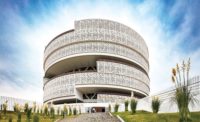Award of Excellence
The Navy Federal Credit Union’s (NFCU) new call center in Pensacola, Florida, is the greenest building on the winners list this year. The 62,000-square-foot structure at Heritage Oaks Commerce Park is only the second LEED Gold–certified building in the state. Architecture, interiors, and graphic design firm ASD provided comprehensive design services to kick-start what the world’s largest credit union has come to call “the Pensacola Project.”
The first in a future four-office-building complex, ASD’s building includes fitness facilities with personal trainers, a health clinic, mothering rooms, dining services, training rooms, member services, conferencing, and data centers in addition to the call center. Like every business that wants a green building, NFCU sought to reduce energy expenses, but it also expected environmental initiatives to benefit employee well-being, aiming to reduce health-care costs and improve employee productivity and retention.
One of the first things people mention when speaking about the facility is the quality of the air indoors. The U.S. Green Building Council is still developing a design guide for air quality, but ASD saw no cause to wait. Air-filtration systems work in tandem with an enormous amount of oxygen-producing foliage, largely in the form of a wall of bamboo running nearly 400 feet through the center of the building.
The orientation and organization of the simple rectilinear structure maximize views of the natural wetlands nearby, while minimizing heat gain in the warm Florida climate. The call center features a glass exterior running the entire length of the building. Circulation and support spaces buffer the room from southern and western exposure. High-performance wall panels form a solar shade and reflector at the window level, transmitting diffuse light into the work space.
The architects specified workstations that are 86 percent recyclable and contain 27 percent recycled materials. The lightweight system features a series of screens and canopies stretched between poles to form low-rise personal space. ASD designed nature graphics to print on the screens. Arranging the workstations close to the window wall takes advantage of daylight as a lighting source, which the building manipulates and augments using automated shade devices and a system that adjusts the energy-efficient lighting fixtures depending on the daylight-harvest performance.
Further improving the workday experience, pressurized raised floors provide two air diffusers for each employee, with individualized heating and cooling controls. A fitness trail around the site encourages jogging and walking. Along the trail, gazebos with benches provide quiet places to work on a nice day.
Many businesses hesitate to take on the initial cost required for a LEED Gold building, but Navy Federal has found the result worth repeating. ASD is now completing two additional NFCU buildings at Heritage Oaks totaling 300,000 square feet, and expects each to earn LEED Gold certification at a minimum.
Navy Federal recruiters testify that their job has become easier. Many new applicants come referred by satisfied employees. NFCU reports reduced employee turnover compared to its other operations centers. The company is also monitoring the Pensacola project’s energy, water, maintenance, and operation costs to measure against its other call centers, hoping that it will continue to find that good design promotes well-being and builds stronger business.


